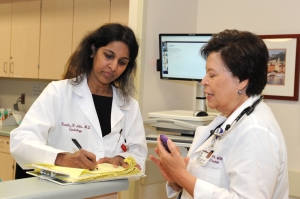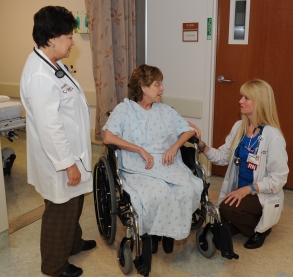
Cardiac Surgery
 The Cardiac Surgery Team is available 24 hours a day, 365 days a year.
Experienced and dedicated Cardiovascular and Thoracic Surgeons lead a
team of lifesaving healthcare professionals. The Team consists of Cardiac
Anesthesiologists, Perfusionists Registered Nurses and a Surgical Scrub
Team. The Center’s high volume of surgeries and low morbidity and
mortality attest to the quality of care provided by our expert team. Procedures
performed include, but are not limited to: coronary artery bypass graft
surgery, valve replacement or repair, aortic aneurysm repair, heart defect
repairs, and minimally invasive surgeries. For those appropriate patients
for a minimally invasive procedure, the incisions are smaller which enhances
quicker healing, and the patient experiences less pain.
The Cardiac Surgery Team is available 24 hours a day, 365 days a year.
Experienced and dedicated Cardiovascular and Thoracic Surgeons lead a
team of lifesaving healthcare professionals. The Team consists of Cardiac
Anesthesiologists, Perfusionists Registered Nurses and a Surgical Scrub
Team. The Center’s high volume of surgeries and low morbidity and
mortality attest to the quality of care provided by our expert team. Procedures
performed include, but are not limited to: coronary artery bypass graft
surgery, valve replacement or repair, aortic aneurysm repair, heart defect
repairs, and minimally invasive surgeries. For those appropriate patients
for a minimally invasive procedure, the incisions are smaller which enhances
quicker healing, and the patient experiences less pain.
Understanding Heart Surgery
The Cardiac Surgery Team performs elective as well as emergency heart surgery. The most common procedures performed by the team are coronary artery bypass graft surgery and heart valve repair or replacement. The surgeons gain access to the heart through the breastbone, or if the patient is a candidate for minimally invasive open heart surgery the surgeon gains access through a smaller incision between the ribs on the right or the left side of the chest. The heart is stopped and cooled. The blood that normally would be pumped by the heart is sent through a heart-lung machine. In coronary bypass surgery, the saphenous (leg) vein, radial (forearm) artery and/or the internal mammary (chest wall) artery are used to bypass the blocked heart arteries. This is called a graft. One end will be attached to the ascending aorta, the large artery that carries oxygen-rich blood from the heart to the rest of the body. The other end of the graft will be attached to a coronary artery below the blocked area. It is just like being on the freeway with bumper to bumper traffic, you would take the exit to bypass the blocked area. This procedure improves the blood supply to the heart muscle, which is intended to relieve symptoms and prevent damage. Valve repair with an annuloplasty ring or valve replacement surgery with either a tissue or mechanical valve improves the function of the heart as a pump. Before any valve surgery, patients need to complete all dental work. Dental infections can allow bacteria to enter the bloodstream and infect the new heart valve- a condition that is very hard to treat.
After Valve surgery patients need to:
- Possibly take a blood thinner
- Take antibiotics about an hour before going to the dentist or prior to any invasive procedure or surgery
- Report any skin, foot or hand infections to the doctor so that they can be treated aggressively to prevent spreading the infection to the blood or the heart valve.
- You should report fevers that are high, last a long time or keep coming back because fevers may indicate an infection that could spread to the blood or new heart valve. The main goal of heart surgery is to enable patients to resume an active and satisfying life.
Preparation For Heart Surgery
Surgery Scheduled Electively With Preadmission
After meeting with the heart surgeon at the hospital or their office, surgery is scheduled through the Cardiac Surgeon’s Office. Pre-surgery education is provided to you and your family before your scheduled procedure.
You will be required to come to the hospital as an outpatient prior to your heart surgery to have preoperative testing completed the day prior to surgery. You will need to bring your insurance information with you and a list of your current medication. You will visit the departments listed below in the following order:
1. Pre-Admit Unit (PATS)
PATS is located in the Robert and Beverly Lewis Out Patient Pavilion right next to the hospital. You will register and complete your pre-admission testing to include blood work, EKG and Chest x-ray. Do not remove the red wristband. PATS hours are from 8:00 a.m. to 4:30 p.m.
2. Admitting
The day of surgery you will come to the hospital at 5:00 a.m. Check in with the front desk and they will direct you to the Admitting Office. It is located just off the front lobby on the first floor and is open Monday through Friday at 5:00 a.m.
Preparation
You should not eat or drink anything after midnight the night before your scheduled surgery. Check with your doctor about taking your regular medications on the day of the procedure. If you take any blood thinners, vitamins, or supplements you will need to stop them 1 week prior to surgery.
The Day of Admission/Surgery
You need to arrive at the hospital at 5 a.m. the day of surgery. This allows for admission and preparation. Upon arrival please go directly to the Admitting Office located just off the front lobby on the first floor. You will then be escorted to your room. In preparation for surgery, you will have your hair removed with clippers from your neck to ankles. You will meet other members of the Cardiac Surgery Team, including the nursing staff and anesthesiologist. An intravenous line will be started in your arm.
Family Support
For comfort and privacy, many families return home during the surgery. Your family will be updated on a regular basis during the surgery to inform you of the progress of surgery. As surgery nears completion, family members are given information regarding the patient’s time of arrival out of surgery and when you may visit. Family members are welcome to wait in the Intensive Care Waiting Room on the 2nd floor by elevator E, or the front lobby, should they so desire. Visits from family and close friends can help speed recovery. For information regarding visiting, please refer to the hospital Visitors Guide.
Recovery and Rehabilitation
Recovery begins in the CVICU (Cardiovascular Intensive Care Unit). You can expect to be in the hospital for 5-7 days, including 1-2 days in the Intensive Care Unit. Each patient’s temperature, blood pressure, heart rate, and heart rhythm, as well as other parameters, are closely monitored. A breathing tube in the windpipe aids breathing. The patient cannot talk during the time this tube is in place. A stomach tube in the nose or mouth acts to prevent nausea and vomiting. The nurses and respiratory therapists instruct the patients to cough and help them perform deep breathing exercises to clear their lungs and upper airways.
For the first 1-3 days of recovery, patients will have chest tubes to help keep the lungs expanded and drain any fluid from the surgery site. Pressure monitoring lines in the blood vessels allow close surveillance of blood pressures and heart function. Patients may also have temporary pacemaker wires in case the heart rate slows.
Throughout the post-operative recovery period, patients can anticipate assistance from several members of the Cardiac Care Team. In addition to doctors and nurses, a respiratory therapist, dietician, physical therapist, Cardiac Surgery coordinator and if necessary, social worker, will visit. A caseworker from your health insurance provider may assist you and your family with home and discharge planning.
As recovery progresses, patients and their families are educated about the causes and treatment of heart disease, the process of healing and rehabilitation, nutrition, exercise, stress management, emotional adjustments, and smoking cessation. They are also given information on our Outpatient Cardiac Rehabilitation Program.
The Cardiac Surgery Team performs elective as well as emergency heart surgery. The most common procedures performed are coronary artery bypass, graft surgery, and heart valve replacement. Surgeons gain access to the heart through the breastbone, or if the patient is a candidate for minimally invasive open heart surgery the surgeon gains access through a smaller incision between the ribs on the right of the left side of the chest. In coronary bypass surgery, the saphenous (leg) vein radial (forearm) artery and/or the internal mammary (chest wall) artery are used to bypass the blocked heart arteries. This procedure improves the blood supply the heart muscle, which is intended to relieve symptoms and prevent damage. Valve repair or replacement surgery with either a tissue or mechanical valve improves the function of the heart as a pump. The main goal of heart surgery is to enable patients to resume an active and satisfying life.
